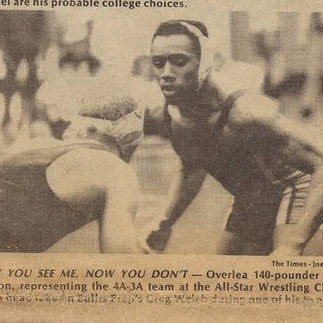Tyrell Gordon is a 54-year-old former Class 4A-3A state champion at Overlea and Mid-Eastern Athletic Conference title-winner at Morgan State who has officiated high school wrestling for eight years.
“I would say that I averaged about six-to-eight takedowns per match,” said Gordon, who has been a “Trakman” for Amtrak for the past two years. “I would consider myself to have been a takedown technician.”
Legacy Wrestling sought Gordon’s perspective on his view of how the following three changes have affected the sport.
For the 2024-25 season, the National Federation of State High School Associations (NFHS) Wrestling Rules Committee has implemented the “three-point takedown” and the “four-point nearfall” rules along with the “one point of contact” inbound directive into high school wrestling.
The changes mirror similar changes previously made in college wrestling, which increased the value of a takedown from two points to three; essentially rewarding more offensive action in the sport.
Tyrell Gordon on the three-point takedown
“The three-point takedown has affected high school wrestling significantly. Matches are quicker, and coaches are pushing for their wrestlers to execute more takedowns. As a referee, I hear coaches telling their wrestlers to let their opponents up more often."
“If the wrestler cannot get a six-point pin, then the coaches are opting for the five-point technical fall, where the wrestler has to beat his opponent by 15 points. So, that means it’s a maximum of six takedowns that have to be initiated and completed to secure the win balanced against the points scored by their opponent."
“This has resulted in higher points required for an ending score. For example, if the losing wrestler has eight points, then the winning wrestler has to have 23 points to win. This has also resulted in quicker matches."
“When I was wrestling, trading two points for one point was often my strategy to win. It would have definitely been a lot easier for me to be more dominant given the three-point takedown being used in this era of wrestling.”
Tyrell Gordon on the four-point nearfall
“The four-point near fall is a great addition also. This adds more points to your total. Also, if a wrestler calls for an injury while on his back, he will give up an additional point that will result in five points being awarded for the nearfall.”
Tyrell Gordon on the one point of contact
“The third addition to new rules which has been affecting wrestling is the “one point of contact rule. This rule allows for either wrestler to have one point of contact in bounds while obtaining points for a takedown, near-fall, or fall. Matches are not easily stopped near the out of bounds line. The downfall to this is that more wrestling is getting closer to the gym floor.”
Tyrell Gordon’s Career Wrestling Accomplishments, At A Glance
High School: Coached by Wavie Gibson at Walbrook (1986-1988) District Champion; Third at McDonogh Tournament; Fourth MSAs at 140 pounds (Record as a sophomore- 14-7; as a junior 18-5)
Coached by Pete Chakmakis at Overlea (1988-89) Baltimore County, Class 4A-3A North and Class 4A-3A state champion at 140 pounds. (Record as a senior - 27-5).
Senior All-Star Classic: Defeated Greg Welch of Bullis (Three-time St. Albans’ champ, one-time Outstanding Wrestler; Two-Time IAC champ; seventh, third and first at National Preps). Defeated Class 2A-1A state champ Ken Mauk of Perryville.
1991: Military USAREUR Champ; First Place at 149.5; Freestyle Champ; Greco Roman Third Place.
1994: Morgan State MEAC Champ at 142 pounds
1995-1997: Milford Mill– Coached two-time Class 2A-1A state champ Greg Forbes (189/275).
2008-2020: Poly assistant to Wavie Gibson.








